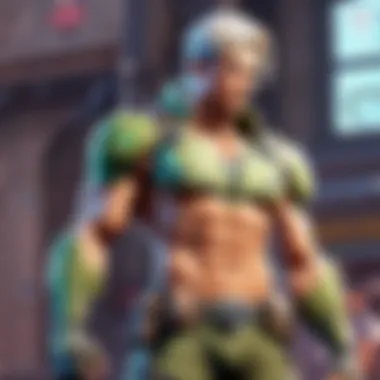Mastering Sage City Support in Valorant: A Comprehensive Guide


Game Overview
In this section, we will delve into the intricate world of Valorant, a popular tactical shooter game that has captivated gamers worldwide. Valorant combines elements of precision shooting and strategic team play to create a dynamic gaming experience. The game's primary objective revolves around two teams, each aiming to either plant or defuse a spike, adding an intense competitive edge to gameplay. For those unfamiliar with the game's roots, Valorant was developed by Riot Games, renowned for their hit MOBA League of Legends. The roster of playable agents in Valorant brings a diverse range of unique abilities and playstyles to the table, each crucial in shaping winning strategies.
Strategy Guides
For players new to Valorant, understanding the basics is essential. Beginners benefit from honing their aim, learning map layouts, and effective communication with teammates. Advanced players, on the other hand, delve into intricate tactics like baiting enemies, mastering agent synergy, and predicting opponents' movements based on sound cues. Map-specific strategies offer a tailored approach to each game environment, considering chokepoints, sightlines, and game objectives. Delving into agent-specific tactics and playstyles uncovers the nuances of utilizing each agent's abilities effectively, whether for utility, crowd control, or fragging.
Patch Updates
Keeping abreast of game patches is integral to staying competitive in Valorant. We summarize recent updates that detail changes to agents, weapons, and maps, providing insights into the evolving meta. Community feedback on patch notes is essential, influencing player strategies and developer decisions. Predicting the direction of upcoming updates involves analyzing current game trends, professional players' feedback, and Riot Games' design philosophy.
Esports Coverage
Valorant's thriving esports scene provides a platform for top players to showcase their skills on a global stage. Recent esports events highlight the intensity and strategical depth of competitive play, offering viewers thrilling matches and unforgettable moments. Analysing tournament outcomes and predicting future events contributes to a deeper understanding of the professional meta, strategies, and standout players shaping the competitive landscape.
Player Community
The vibrant player community surrounding Valorant fosters creativity, camaraderie, and competitive spirit. We shine a spotlight on featured player highlights, recognizing exceptional talent and impressive gameplay moments. Community-created content showcases fan art, frag movies, and guides that enrich the gaming experience for all. Delving into forum discussions reveals insights on trending topics, balance suggestions, and player experiences, creating a collaborative space for sharing knowledge and passion for the game.
Introduction
Sage City support in Valorant is a crucial aspect that can greatly impact a team's performance in the renowned tactical shooter game. Understanding the intricacies of Sage's supportive role is paramount for players striving to enhance their gameplay and secure victories. By delving into the nuances of support strategies tailored for Sage, players can elevate their skills and contribute significantly to their team's success.
Overview of Sage in Valorant
Sage, one of the cornerstone agents in Valorant, epitomizes the support role with her healing and defensive abilities. Known for her prowess in sustaining teammates and controlling map areas with barriers, Sage plays a pivotal role in shaping team dynamics and outcomes in matches. Her unique skill set not only aids in maintaining team health but also strategically influences engagements, making her an indispensable asset in any lineup.
Importance of Support Role
The support role in Valorant is often undervalued but holds immense significance in dictating the flow of a match. Support agents like Sage provide crucial utility, including healing abilities, barriers, and resurrection, that can turn the tide of battle. Mastering the intricacies of the support role is essential for creating a well-rounded team composition that can adapt to various situations effectively. By grasping the importance of support roles, players can optimize team synergy and capitalize on strategic opportunities, ensuring a competitive edge in gameplay.


Basic Support Strategies
In the realm of competitive gaming like Valorant, mastering basic support strategies forms the bedrock of success and team efficiency. Understanding the nuances of support play is crucial for players aiming to elevate their gameplay. These strategies not only enhance individual performance but also contribute significantly to the overall team synergy. By delving into the basics of support tactics, players can unlock a realm of possibilities in optimizing their gameplay. From healing techniques to decisive barrier placements, each aspect of basic support strategies plays a pivotal role in shaping the outcomes of intense gameplays.
Healing Techniques
Effective Use of Sage's Healing Abilities
Within the tactical world of Valorant, Sage's healing abilities stand out as a cornerstone of support play. The effectiveness of Sage's healing stems from its capability to sustain teammates through intense firefights and skirmishes. This skill not only boosts team morale but also provides a strategic advantage in outlasting opponents. The key characteristic of Sage's healing is its versatility in turning the tides of battle by rejuvenating wounded allies at critical moments. Players who master the art of effective healing with Sage can significantly impact the course of a match, showcasing the importance of this technique in competitive gameplay.
Prioritizing Healing in Team Engagements
Amidst the chaos of combat, prioritizing healing can spell the difference between victory and defeat. Recognizing the strategic value of healing in team engagements is paramount for success in Valorant. By focusing on healing teammates efficiently, players can ensure sustained pressure on the opposing team while maintaining a formidable presence on the battlefield. However, strategic decision-making is essential when allocating healing resources, as timing and target selection play crucial roles in maximizing the impact of Sage's supportive abilities. Prioritizing healing in strategic moments not only reinforces team cohesion but also showcases a player's tactical acumen in high-pressure situations.
Barrier Placement
Strategic Wall Placement for Map Control
Strategic wall placement serves as a fundamental aspect of support play in Valorant, particularly with Sage's unique abilities. By strategically deploying walls for map control, players can dictate the flow of gameplay and manipulate enemy movements. The key characteristic of Sage's walls lies in their dual functionality of creating defensive barriers and obstructing opponent's sightlines. This choice proves advantageous, especially when securing key objectives or defending bomb sites. However, the proper utilization of walls requires foresight and spatial awareness to ensure maximum efficacy while minimizing potential drawbacks.
Blocking Enemy Vision and Paths
Blocking enemy vision and paths through Sage's barriers is a tactical maneuver essential for gaining a strategic edge in Valorant. By disrupting opponent's sightlines and restricting their movement options, players can force adversaries into unfavorable positions, creating opportunities for advantageous engagements. The key characteristic of this tactic lies in its capacity to disorient opponents and disrupt their planned strategies, instilling chaos in their ranks. While blocking enemy vision and paths can provide significant advantages, players must also be mindful of potential counter-strategies and adapt their barrier placements accordingly to maintain a competitive advantage in dynamic game scenarios.
Advanced Support Tactics
In this section of the article, we delve into the critical realm of Advanced Support Tactics in Valorant. Understanding and mastering Advanced Support Tactics can elevate a player's effectiveness in the support role within the game. By focusing on specific elements such as strategic decision-making, precise execution, and situational awareness, players can significantly influence the outcome of rounds and matches. Advanced Support Tactics not only contribute to individual performance but also play a pivotal role in enhancing team synergy and overall success.
Revive Usage
Selecting Optimal Moments for Reviving Teammates:


A key aspect of Sage's kit in Valorant is the ability to revive fallen teammates, making her an invaluable asset to any team. Selecting Optimal Moments for Reviving Teammates requires a keen understanding of the game flow, map control, and opponent positioning. By strategically choosing the right moments to use this ability, players can swing the momentum of a round in their team's favor. The strategic revival of a crucial teammate can disrupt enemy plans, create advantageous situations, and ultimately lead to round victories. However, mistimed revives can expose the team to vulnerabilities and squander this powerful ability.
Positioning for Safe and Effective Resurrections:
Another critical aspect of Sage's revive ability is positioning for safe and effective resurrections. Sage players need to balance the risk and reward of reviving a teammate amidst the chaos of battle. Optimal positioning allows Sage to safely execute the revive, avoiding immediate threats and potential ambushes. By positioning strategically, Sage can ensure the successful resurrection of a teammate without putting herself or the revived player in unnecessary danger. Effective positioning maximizes the impact of Sage's revive ability, turning the tide of engagements in favor of her team.
Ultimate Management
Coordinating Sage's Ultimate for Maximum Impact:
Sage's ultimate ability, the Resurrection, can be a game-changer when used effectively. Coordinating Sage's Ultimate for Maximum Impact involves timing, communication, and understanding of enemy strategies. By synchronizing the resurrection with team pushes or holds, players can catch opponents off guard and create numerical advantages. Additionally, strategic coordination can force enemies to rethink their tactics and adapt to the revived teammate, gaining crucial map control and round advantage.
Combining Ultimates with Team Strategies:
In the high-level gameplay of Valorant, combining ultimates with team strategies can lead to devastating outcomes for the opposing team. Sage's ultimate synergizes well with various agent abilities, such as area denial or crowd control ultimates. By combining ultimates strategically, teams can create domineering plays that secure rounds and demoralize opponents. Understanding the synergy between Sage's ultimate and other agent abilities is crucial for maximizing the team's overall performance and achieving victory in competitive scenarios.
Team Coordination and Communication
In the competitive landscape of Valorant, effective team coordination and communication play a pivotal role in achieving success. The ability to work cohesively with teammates, exchange crucial information, and synchronize strategies can often be the deciding factor between victory and defeat. Team coordination involves orchestrating plays, setting up defenses, and executing tactics in unison. Communication, on the other hand, entails sharing vital details about enemy movements, positioning, and map control.
One of the key elements of team coordination and communication is the strategic use of callouts and information sharing. This involves verbally communicating important details such as enemy locations, spotted utility usage, and potential ambush points to support your team's decision-making process. By providing timely and accurate information, players can assist their teammates in making informed choices during engagements. Furthermore, efficient communication can aid in coordinating synchronized pushes, rotations, and defensive setups, ultimately leading to a more cohesive team dynamic and improved overall performance on the battlefield.
Callouts and Information Sharing
Effective Team Communication for Support Plays
Effective team communication for support plays is essential for maximizing the impact of Sage's supportive abilities. Clear and concise communication ensures that teammates are aware of Sage's healing capabilities, ultimate readiness, and strategic positioning. By effectively communicating your intentions to support plays, such as prioritizing healing for key players or setting up defensive barriers, you enhance teamwork and create opportunities for coordinated plays that can turn the tide of a match.
Utilizing Ping System for Quick Coordination
The ping system in Valorant is a powerful tool for quick and efficient coordination during intense moments in a match. By utilizing the ping system, players can easily mark enemy locations, point out tactical positions, and suggest strategies without the need for extensive verbal communication. This streamlined method of communication allows for rapid decision-making, especially in high-pressure scenarios where time is of the essence. Integrating the ping system into your communication strategy adds an extra layer of coordination to your team's gameplay, fostering better synergy and enhancing overall performance.


Synergy with Other Agents
A crucial aspect of Sage's role in support is the synergy she can achieve with other agents on the team. Understanding team composition for synergistic playstyles involves identifying how Sage's abilities complement those of other agents to create powerful combinations. By synergizing abilities with agents who can capitalize on her heals, crowd control, and utility, Sage can elevate her supportive impact and enable strategic plays that capitalize on the unique strengths of each agent. This synergy enhances team coordination, provides tactical flexibility, and increases the team's overall effectiveness in combating opponents.
Understanding Team Composition for Synergistic Playstyles
The understanding of team composition for synergistic playstyles is crucial for optimizing Sage's supportive role. By selecting agents that complement Sage's defensive abilities with offensive prowess or crowd control, teams can create well-rounded compositions that cover each other's weaknesses and enhance their strengths. Synergizing with agents who can capitalize on Sage's abilities not only amplifies her supportive capacity but also opens up opportunities for dynamic plays and strategic maneuvers that catch opponents off guard.
Combining Sage's Abilities with Other Agents
Combining Sage's abilities with those of other agents requires meticulous planning and coordination to maximize their collective potential. Pairing Sage's crowd control abilities with an agent capable of swift executions, sniping skills, or area denial can create formidable strategies that devastate enemy teams. The key lies in understanding how each agent's strengths complement Sage's supportive toolkit and strategically using these synergies to gain a competitive edge. By combining Sage's healing, barriers, and ultimate with other agents' offensive or defensive capabilities, teams can create synergistic plays that showcase the full potential of their tactical approach.
Sage City Support Tips for Different Maps
In the realm of Valorant, the significance of Sage City support tips tailored specifically for various maps cannot be overstated. Understanding how Sage's support abilities can be optimized based on the distinct layouts of Bind, Haven, and Split is essential in elevating gameplay to tactical excellence. These map-specific strategies delve into the nuances of positioning, ability usage, and team coordination unique to each arena, offering players a strategic edge in navigating the complexities of different maps. By honing in on Sage City support tips for Bind, Haven, and Split, players can adapt their playstyle effectively to suit the specific demands of each map, enhancing their overall performance and contribution to the team's success.
Bind
When delving into the map-specific support strategies for Sage on Bind, a key focal point emerges on leveraging Sage's abilities to control crucial chokepoints and strategic areas of the map. The application of Sage's barrier wall in restricting enemy movement and sightlines, particularly on Bind where map control is paramount, can significantly influence the outcome of engagements. By strategically placing barriers to impede enemy advancements and create advantageous angles for team engagement, Sage players can dictate the tempo of the match and provide vital support to teammates seeking cover or map dominance. Understanding the intricacies of Bind's layout and correlating them with Sage's supportive capabilities grants players a tactical advantage, optimizing their contributions to the team's success in the pivotal moments of battle.
Haven
Turning attention to Haven, the optimal support tactics for Sage on this map revolve around adapting Sage's abilities to the three-site setup unique to Haven. Maximizing healing efficiency, barrier placement, and ultimate usage to accommodate the diverse map layout and multiple potential points of conflict is crucial for Sage players aiming to excel on Haven. By mastering the art of balancing healing teammates across different sites, strategically deploying barriers to block off key entry points, and synchronizing ultimate abilities with team pushes or defenses, Sage players can bolster their team's resilience and combat effectiveness on Haven. The strategic versatility required to navigate the complexities of Haven while capitalizing on Sage's potent support toolkit underscores the pivotal role Sage plays in shaping the outcome of engagements on this dynamic map.
Split
Lastly, in the realm of Split, adeptly navigating support roles with Sage entails understanding how to leverage Sage's abilities to control map areas split into distinct vertical levels. A key consideration lies in utilizing barriers and healing abilities effectively to support teammates traversing between the upper and lower sections of the map, maintaining map presence, and gaining strategic advantages based on vertical positioning. By capitalizing on Sage's toolkit to cover sightlines, provide healing support to teammates across different levels, and strategically positioning for resurrection opportunities, players can elevate their team's cohesion and map control on Split. The unique verticality and layout challenges of Split accentuate the importance of Sage's support capabilities in orchestrating successful engagements and providing critical assistance to teammates in navigating this intricate battlefield.
Conclusion
Mastering Sage's Support
Delving into the realm of mastering Sage's support abilities is like uncovering the hidden gems of Valorant's strategic tapestry. Adeptly handling Sage's toolkit can turn the tides of battle, offering a lifeline to teammates in dire situations. In mastering Sage's support, players unlock the potential to be a game-changer—an indispensable pillar in their team's success. From timely healing to strategic barrier placements, every action matters and contributes to shaping the outcome of engagements. Embracing Sage's support not only requires technical prowess but also demands a keen sense of game understanding and positioning. By honing these skills, players can wield Sage's abilities with precision, securing victories and earning the admiration of comrades.
Continuous Improvement
The path to greatness is paved with the stones of continuous improvement, and in the realm of Sage City support, this mantra holds immense relevance. Every match offers a learning opportunity, a chance to analyze past decisions, and refine future strategies. Embracing a mindset of continual growth and evolution is key to excelling in the competitive landscapes of Valorant. Continuous improvement in Sage's support requires proactive reflection, adapting to changing meta trends, and honing individual skills. By consistently seeking avenues to enhance gameplay, players not only elevate their personal performance but also contribute positively to their team dynamics. The journey of continuous improvement is a rewarding one, promising growth, success, and the sweet taste of victory to those who embark on it.



